

Timeline of the release and transfer of Guantanamo Bay detainees. In late 2008 the Department of Defense published a list of the Guantanamo captives who died in custody, were freed, or were repatriated to the custody of another country.[1] This list was drafted on October 8, 2008, and was published on November 26, 2008.
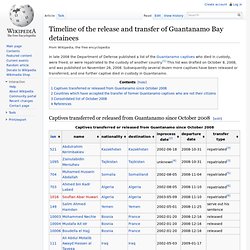
Subsequently several dozen more captives have been released or transferred, and one further captive died in custody in Guantanamo. Captives transferred or released from Guantanamo since October 2008[edit] Countries which have accepted the transfer of former Guantanamo captives who are not their citizens[edit] Consolidated list of October 2008[edit] References[edit] Combatant Status Review Tribunal, wikipedia. Trailer where the Combatant Status Review Tribunals were held.
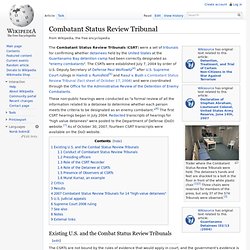
The detainee's hands and feet are shackled to a bolt in the floor in front of the white plastic chair.[1][2] Three chairs were reserved for members of the press, but only 37 of the 574 Tribunals were observed.[3] Existing U.S. and the Combat Status Review Tribunals[edit] The CSRTs are not bound by the rules of evidence that would apply in court, and the government’s evidence is presumed to be “genuine and accurate.” The government is required to present all of its relevant evidence, including evidence that tends to negate the detainee’s designation, to the tribunal.
Unclassified summaries of relevant evidence may be provided to the detainee. Report of the USA to the UN Committee Against Torture. The Periodic Report of the United States of America to the United Nations Committee Against Torture is periodically submitted by the United States government, through the State Department, to the United Nations Committee Against Torture.
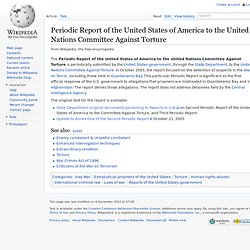
Enhanced interrogation techniques, wikipedia. Enhanced interrogation techniques or alternative set of procedures are euphemisms the George W.

Bush administration used to describe methods of torture, including hypothermia, stress positions and waterboarding. The Central Intelligence Agency (CIA) and the Department of Defense (DoD) employed these methods at Bagram, in black sites or secret prisons, the Guantanamo Bay detention camps, and Abu Ghraib on prisoners[1] after the September 11 attacks, including notably Abu Zubaydah, Khalid Shaikh Mohammed, and Mohammed al-Qahtani. Debates arose over the legality of the techniques—whether or not they had violated U.S. or international laws (such as the UN Convention against Torture) and whether they constitute torture.
History of approval by the Bush administration[edit] ABC News reported on April 9, 2008 that "the most senior Bush administration officials discussed and approved specific details of how high-value al Qaeda suspects would be interrogated by the Central Intelligence Agency. " Gitmo suicide attempts, wikipedia. The United States Department of Defense (DOD) had stopped reporting Guantanamo suicide attempts in 2002.
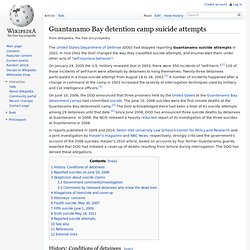
In mid-2002 the DoD changed the way they classified suicide attempts, and enumerated them under other acts of "self-injurious behavior". On January 24, 2005 the U.S. military revealed that in 2003, there were 350 incidents of "self-harm. "[1] 120 of those incidents of self-harm were attempts by detainees to hang themselves. Twenty-three detainees participated in a mass-suicide attempt from August 18 to 26, 2003.[1] A number of incidents happened after a change in command at the camp in 2003 increased the severity of interrogation techniques used by military and CIA intelligence officers.[1] In reports published in 2009 and 2010, Seton Hall University Law School's Center for Policy and Research and a joint investigation by Harper's magazine and NBC News, respectively, strongly criticized the government's account of the 2006 suicides.
List of Gitmo Bay detainees, wikipedia. The Washington Post maintains a list of the detainees known or suspected to have been held in Guantánamo Bay.[3] The United States has long maintained camps at Guantánamo Bay for attempted illegal immigrants captured while trying to get to the United States, usually from Cuba, Haiti, or the Dominican Republic.
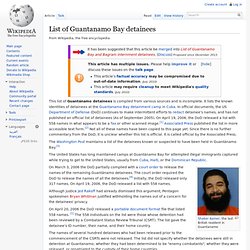
On March 3, 2006 the DoD partially complied with a court order to release the names of the remaining Guantánamo detainees. The court order required the DoD to release the names of all the detainees.[4] Initially, the DoD released only 317 names. On April 19, 2006, the DoD released a list with 558 names. Although justice Jed Rakoff had already dismissed this argument, Pentagon spokesmen Bryan Whitman justified withholding the names out of a concern for the detainees' privacy. Guantanamo Bay detention camp, wikipedia. Camp X-Ray, 2002 U.S.
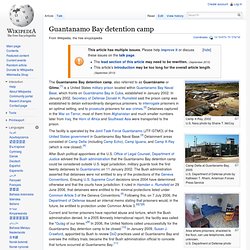
Navy photo by Shane T. McCoy Camp Delta at Guantanamo Bay, 2005 U.S. Department of Defense photo by Kathleen T. Rhem, American Forces Press Service. The Guantanamo Files. In its latest release of classified US documents, WikiLeaks is shining the light of truth on a notorious icon of the Bush administration’s "War on Terror" — the prison at Guantánamo Bay, Cuba, which opened on January 11, 2002, and remains open under President Obama, despite his promise to close the much-criticized facility within a year of taking office.

In thousands of pages of documents dating from 2002 to 2008 and never seen before by members of the public or the media, the cases of the majority of the prisoners held at Guantánamo — 765 out of 779 in total — are described in detail in memoranda from JTF-GTMO, the Joint Task Force at Guantánamo Bay, to US Southern Command in Miami, Florida. These memoranda, known as Detainee Assessment Briefs (DABs), contain JTF-GTMO’s recommendations about whether the prisoners in question should continue to be held, or should be released (transferred to their home governments, or to other governments).
(Andy Worthington) 1. Personal information 2. 3.